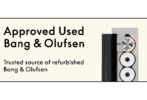
BeoMaster 1700 (1980)
Beomaster 1700 was an AM/FM receiver in a class of its own. It was defiantly different when most high fidelity components still tended to look alike. Different in its design, its use of technology and the benefits it offered. The FM section had facilities for presetting 5 favourite stations which could then be tuned instantly […]
Overview
Beomaster 1700 was an AM/FM receiver in a class of its own. It was defiantly different when most high fidelity components still tended to look alike. Different in its design, its use of technology and the benefits it offered.
The FM section had facilities for presetting 5 favourite stations which could then be tuned instantly by pressing a button. The AM section covered both the Long and Medium wavebands. Hybrid filters were used to achieve high selectivity (the tuner’s ability to discriminate between the desired station and unwanted stations adjacent to it)The stereo amplifier was rated at 2 x 30 watts RMS with high quality sound reproduction up to the last watt. The tone control circuits were designed so that they could not limit or distort the quality of the reproduced sound before the amplifier’s maximum output level was reached.
All in all, the quality and performance levels of Beomaster 1700 were beyond reproach. As they should be, with the best technology. But what was most interesting was the creative use Bang & Olufsen made of technology – a (then) new operation system which afforded sharp, precise settings that were easy to locate on the scale. Two flexible slider controls formed the centre of this operation system. One was used to regulate volume level, bass, treble and speaker balance. The other was for the precise tuning of stations on Long, Medium and FM wavebands. The sliders had a sensitive, ridged surface that prevented the finger from slipping during operation.
The set’s large glass-covered communication surface, with its clear graphic indications aided easy operation. During use, response was light and immediate. Illuminated markers – light emitting diodes – kept you informed of the set’s operational status at all times. The surface was easy to clean with no irritating dust traps.
A Beogram 1700 and two Beovox C40 hi-fi loudspeakers complemented Beomaster 1700 in creating the well-balanced Beosystem 1700.
Well the above is the official line seen in the brochures. What could not be denied was the design of the 1700 which was innovative to say the least. I some ways it resembled the Beomaster 6000 quad except that it had a manual mechanism and clutches instead of the electrical control of the 6000. It gained a decent glass panel instead of the perspex of the 6000 but was let down by very poor quality plastics in the clutches, tractor drives that slipped and broke and an amplifier which was indirectly coupled compared to the direct coupled 1500 which it had replaced. Although it looked better than the 1500, it could not get close to the performance. Perhaps the beginning of a range designed more for looks than performance.
Product Details
Software
No software information available.
Product Specification
Power output: RMS DIN 2 x 30 W / 4 ohms
2 x 30 watts / 8 ohms
Harmonic distortion: -26 dB <0.1%
Intermodulation: <0.65%
Frequency range: +/- 1.5 dB 20 – 30,000 Hz
Bass control at 40 Hz:: +/- 12 dB
Treble control at 12,500 Hz: +/- 12 dB
FM range: 87.5 – 108 MHz
AM range: LW 147 – 320 kHz
AM range: MW 520 – 1610 kHz
Power supply: 110 – 130 – 220 – 240 V
Power consumption: 10 – 150 W
Dimensions W x H x D: 60 x 10 x 24cm
Weight: 7.2 kg
Connections: Aerial 75 ohms, 300 ohms
RIAA-amplifier: built-in
Phono; tape; 2 sets of speakers
Downloads
No downloads available.
Photo Gallery
No gallery images.
Frequently Asked Questions
No FAQs available.






